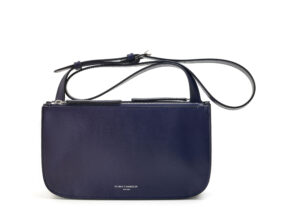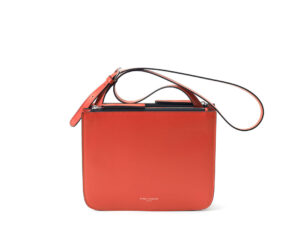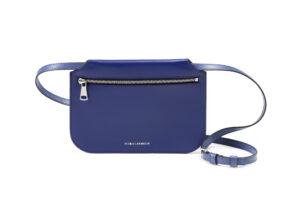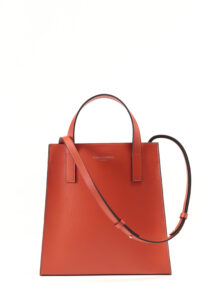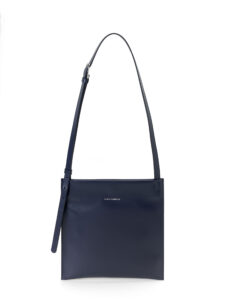Amidst the backdrop of contemporary art and architecture, bathed in the warmth of Mediterranean lights, and enriched by Milan’s culture of understated sophistication, lies a timeless realm of elegance—Flora Carmelin. This exclusive Italian maison has captivated the fashion landscape with its “less is more” philosophy, an ode to simplicity that translates into handbags that are much more than accessories; they are wearable works of art.
In a dialogue between cosmopolitan Milan and the vibrancy of the south, Flora Carmelin crafts bags that enchant with their uniqueness. Each model is meticulously sculpted through a process of subtraction, a celebration of proportions and essential lines. But the surprise lies within: colorful and playful linings that bring joy, a hidden secret within the minimalist and rigorous forms.
In this exclusive interview, we delve into the world of Flora Carmelin through the eyes of its creator, discovering how Milanese culture merges with Mediterranean warmth to create an unrivaled aesthetic. Welcome to the universe of Flora Carmelin, where the aesthetics of uniqueness come to life, and where every bag is a testament to Italian art that accompanies the lives of those who wear them.
Flora Carmelin’s bags are known for their artisanal craftsmanship. How does the brand ensure that each bag is handmade by Italian artisans?
Italian leather craftmanship and its artisanal savoir-faire are at the core of our vision.
We invest time and energies in following closely the process of production in every step.
We were not for the process of delocalization that accompanied the economic growth of China in the nineties, when all brands moved their production to Asia.
In Italy the best-quality of artisanal goods are still produced, and we are happy to keep drawing on this tradition.
Could you tell us more about the rich heritage of Italian leather craftsmanship that inspires Flora Carmelin’s designs?
Flora Carmelin brand is based in Milan, so is the designer Emilia Sala. She was born in a city with austro-hungarian roots, where architecture and Industrial design of the last centuries have been inspired by criteria of refined simplicity and functionality.
What sets Flora Carmelin’s limited-quantity bags apart in terms of their technical expertise and production process?
The designer Emilia Sala is personally involved in every step of creation and production. She imagines a product, designs it, makes the pattern and the first prototype. Then she takes the prototype to the producer, giving detailed instructions about the thickness of materials, etc.
Bags making is like cooking: according to the ingredients you choose, you get a different result.
Flora Carmelin emphasizes high-quality materials. How does the brand source and select the premium leathers used in their bags?
The brand is very much involved in the research of high-quality leathers. In Italy there is a long tanning tradition, we have some of the best producers in the world.
We first get to know them through specialized fairs, then get in touch with them personally.
Going to Lineapelle, an International exhibition of leather, is like going to an art exhibition. The quality and the beauty of certain raw materials is really extraordinary.
Could you elaborate on the connection between Flora Carmelin’s choice of leather, which is linked to the Italian food industry, and the brand’s ethos?
Calves and other animals used for leather goods are not killed for leather accessories, they are killed for food consumption. The use of leather is strongly connected to the world's population food habits.
When the world population will stop eating meat, there will be no more leather.
Were there not the leather industry to recycle leather, there would be the big question of how to dispose of all hides.
In this sense, the use of leather is highly sustainable.
The so-popular "ecoleather" was a clever marketing idea. In fact, it is a synthetic material, and just like plastic it is very difficult to be disposed of.
In terms of sustainability, how does Flora Carmelin align with creating products that stand the test of time and deviate from fast fashion trends?
We choose genuine leather because of its proved durability compared to all synthetic and faux leathers, and because of its beauty. We believe in less is more and are focused on creating long-lasting and timeless products.
Tell us more about the design philosophy of Flora Carmelin. How does it reflect an understated elegance distinct from the fast-fashion culture?
Understatement and refined simplicity are factors rooted in the Milanese culture, and in an International and urban context where the designer was raised.
All models are designed through a process of subtraction, a search for proportions and essential lines.
Could you provide insights into the location where Flora Carmelin prototypes are designed? How does this space influence the creative process?
The prototypes are designed in Flora Carmelin headquarter, where office, workshop and store are located. This is a very special place, which was established in 1947 as a bags factory, and subsequently became a bags repair shop. It is also the place where the designer started to approach the bag making as an apprentice.
The workshop is equipped with very old furniture and technical machines, which nevertheless accomplish their function very well. In the designer's creative process there seems to converge a sense of tradition with a strong influence of contemporary art and architecture that belong to her previous professional education.
What are some of the unique accessories, metallic elements, yarns, and textiles that Flora Carmelin incorporates into their designs, and how are they selected?
All accessories are selected according to criteria of high quality. We use the best-quality YKK zips, our artisans sew our bags with Serafil and Gütermann yarns.
Can you share some future plans or upcoming collections from Flora Carmelin that align with their commitment to Italian craftsmanship and sustainability?
We are currently working on extending the range of our Italian craftsmen according to their specialized skills, in order to be able to confront with growth while increasing the quality of our leather goods.
As far as our research in sustainability, we have not found so far any material so sustainable as leather. Take for instance cactuses, on which many researches have focused in the last years: it is not a durable material yet, so the risk is to be forced to consume more and throw away.




